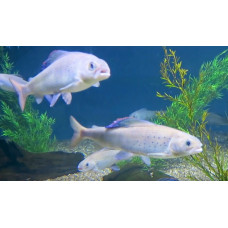Latin name
Thymallus arcticus
Identification
The Arctic grayling has 58 to 62 vertebrae. They have small mouths with small teeth on both jaws. The Arctic grayling can be distinguished from the European grayling by its larger mouth; the upper jaw of the Arctic grayling reaches approximately to the middle of the eye.
Features of fish fins
Dorsal spines (total): 0; Dorsal soft rays (total): 17 - 25; Anal spines: 0; Anal soft rays: 11 - 15.
The dorsal fin is enlarged in adults, especially males, and reaches the adipose fin when extended. However, it is shorter in females. The pelvic fins are long and reach the anal fin in adult males but not in females. The lower lobe of the caudal fin is often longer than the upper lobe. The Arctic grayling differs from the similar European grayling in that it lacks dorsal and anal spines and has more soft rays in these fins.
Fish colouring
This brightly colored fish has a dark purple or blue-black to blue-gray dorsal surface, gray to dark blue sides with pinkish shimmers, and a gray to white ventral surface. There are scattered dark spots on the sides, which are more numerous in frys. There is a dark longitudinal stripe along the lower body between the pectoral and pelvic fins. The dorsal fin is dark with a narrow purple edge and rows of spots ranging from reddish to orange or purple to green. The pelvic fins are dark with irregular diagonal orange-yellow coloration. Dark stripes are present on the adipose, dorsal, anal, caudal, and pectoral fins. This species' coloration is similar to that of the European grayling, but there are peculiarities: in large rivers, there are lighter forms of these fish, and in taiga streams, there are darker forms.
Distribution
The Arctic grayling is widespread in the waters of the Arctic Ocean, from Hudson Bay in Canada to Alaska, as well as in the waters of the North Pacific Ocean, extending to central Alberta and British Columbia in Canada. However, it does not occur naturally in the Fraser and Columbia River basins. However, remnants of native riverine populations persist in the upper Missouri River, specifically in the Big Hole and Red Rock basins. In the wild, Arctic grayling are found in the Arctic Ocean basin in Siberia, from the Ob to the Yenisei, and in some tributaries of the Pechora River in European Russia.
Habitat
This freshwater, benthopelagic species prefers a temperate climate. They live at depths ranging from 30 to 100 meters and mainly inhabit the cold waters of medium to large rivers and lakes. They return to stony streams to breed. They also occur in cold streams, rivers, and lakes in foothill and high mountain regions with high oxygen concentrations.
Size
The maximum recorded length of an Arctic grayling is 76 cm (30 in), and the maximum recorded weight is 3.8 kg (8.4 lb). Juveniles grow rapidly during the first two years of life. The oldest recorded age of an Arctic grayling is 18 years.
Behavior
There are several forms: riverine populations live and spawn in rivers, lacustrine populations live and spawn in lakes, and potamodromous populations live in lakes and spawn in tributaries. They form flocks in moderate numbers.
Food and feeding habits
The various subspecies are omnivorous. The most important food items are crustaceans, insects and their larvae, and fish eggs. Larger specimens become carnivorous, feeding on fish, while juveniles feed on zooplankton and insect larvae.
Reproduction
Spawning occurs in the spring. Adult fish prefer shallow areas of rivers with sandy bottoms and moderate currents. Males are territorial and court females by flashing their brightly colored dorsal fins. The fins are also used to hold females in place while the eggs and milk are released. The fish do not guard the eggs, which are left to mix with the substrate. Though this species does not dig nests, a thin layer of material forms during intense courtship and mating to cover the zygotes. The zygote is small, about 3 mm (0.1 in) in diameter, and the embryo hatches in two to three weeks. The newly hatched embryo remains in the substrate until all the yolk is absorbed. The fish grow to be 12 to 18 mm (0.5 to 0.7 in) long and form shoals on river banks at this time.
Fishing
The Arctic grayling is important economically. It sustains the people of Alaska's North Slope and is one of the most important species for sport fishing.
Relationship with a person
Harmless. It is cultivated commercially for food consumption. It can be used fresh or roasted, grilled, boiled, or baked in the oven.
| Classification | |
| Phylum | Chordata |
| Class | Actinopterygii |
| Squad | Salmoniformes |
| Family | Salmonidae |
| Genus | Thymallus |
| Species | T. arcticus |
| Features | |
| Conservation status | Least Concern |
| Habitat | Pelagic |
| Life span, years | 18 |
| Maximum body weight, kg | 3,8 |
| Maximum length, cm | 76 |
| Sailing speed, m/s | No information |
| Threat to people | Edible |
| Way of eating | Predator |
Arctic grayling
Tags: arctic grayling



